Financial Analysis and Auditing Report: Elmo Software Company Review
VerifiedAdded on 2023/01/03
|9
|1030
|36
Report
AI Summary
This report presents a comprehensive financial analysis of the Elmo Software Company, focusing on auditing and assurance. The analysis includes a preliminary risk assessment, evaluating the company's financial position through ratio analysis for the year 2018, and determining planning materiality. Key aspects covered involve assessing the company's financial performance, liquidity ratios, and associated business risks. The report also delves into the quality and effectiveness of independent audits, emphasizing the auditor's role in ensuring financial statement accuracy and addressing audit concerns by regulators. The analysis utilizes the company's annual report and relevant research papers to support its findings, offering insights into the company's financial health and the significance of auditing practices.

AUDITING AND
ASSURANCE
ASSURANCE
Paraphrase This Document
Need a fresh take? Get an instant paraphrase of this document with our AI Paraphraser
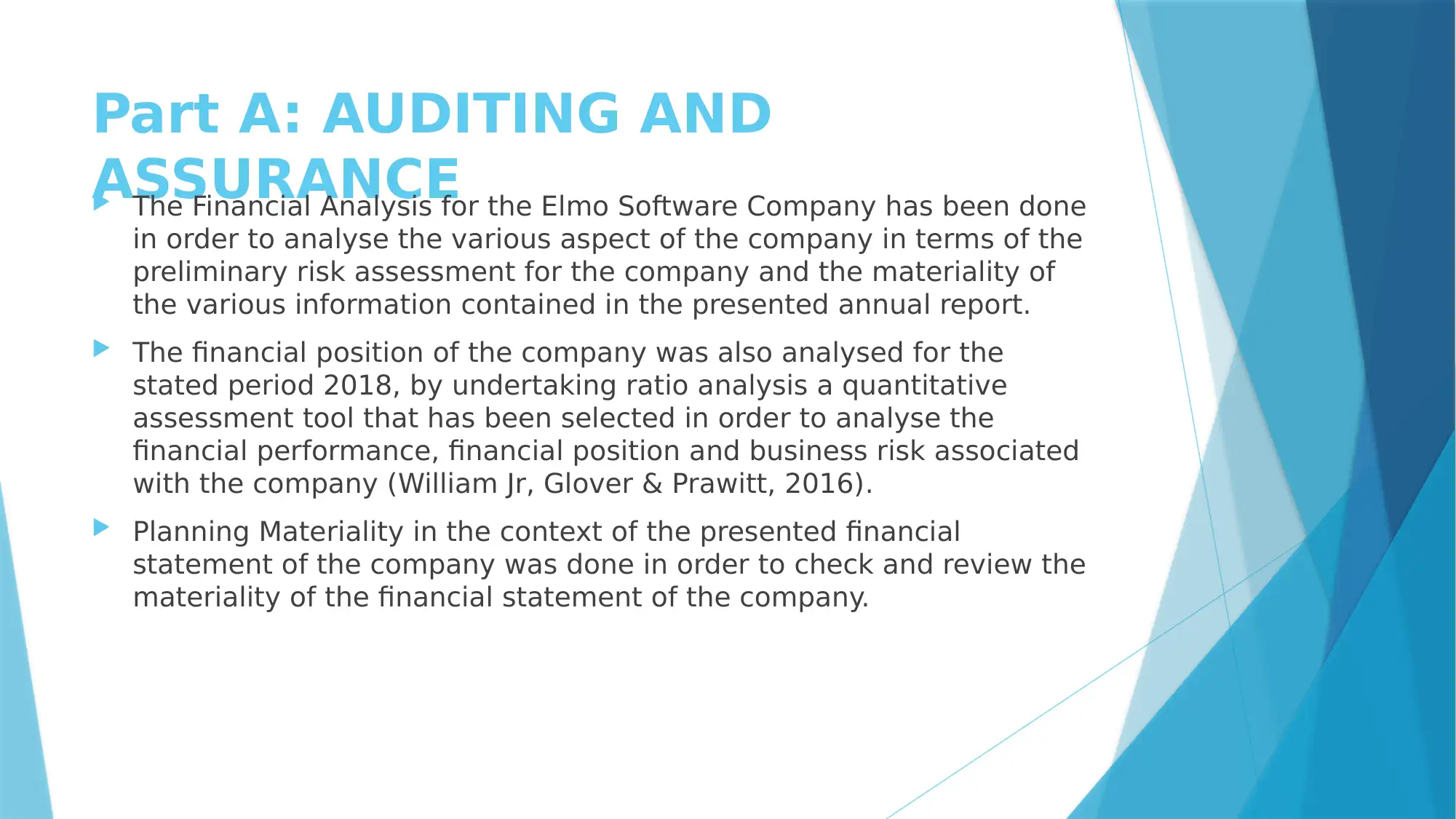
Part A: AUDITING AND
ASSURANCE The Financial Analysis for the Elmo Software Company has been done
in order to analyse the various aspect of the company in terms of the
preliminary risk assessment for the company and the materiality of
the various information contained in the presented annual report.
The financial position of the company was also analysed for the
stated period 2018, by undertaking ratio analysis a quantitative
assessment tool that has been selected in order to analyse the
financial performance, financial position and business risk associated
with the company (William Jr, Glover & Prawitt, 2016).
Planning Materiality in the context of the presented financial
statement of the company was done in order to check and review the
materiality of the financial statement of the company.
ASSURANCE The Financial Analysis for the Elmo Software Company has been done
in order to analyse the various aspect of the company in terms of the
preliminary risk assessment for the company and the materiality of
the various information contained in the presented annual report.
The financial position of the company was also analysed for the
stated period 2018, by undertaking ratio analysis a quantitative
assessment tool that has been selected in order to analyse the
financial performance, financial position and business risk associated
with the company (William Jr, Glover & Prawitt, 2016).
Planning Materiality in the context of the presented financial
statement of the company was done in order to check and review the
materiality of the financial statement of the company.
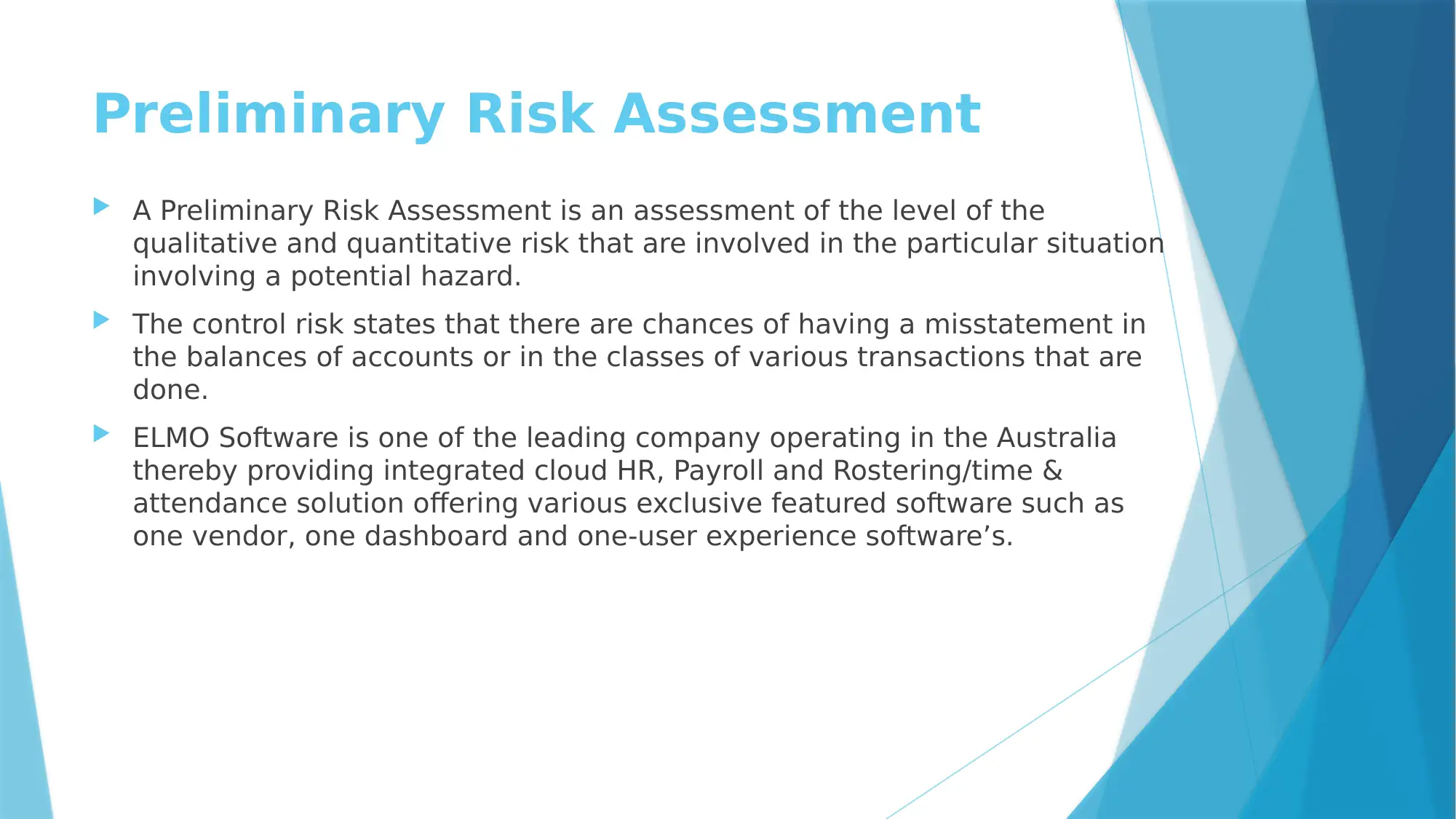
Preliminary Risk Assessment
A Preliminary Risk Assessment is an assessment of the level of the
qualitative and quantitative risk that are involved in the particular situation
involving a potential hazard.
The control risk states that there are chances of having a misstatement in
the balances of accounts or in the classes of various transactions that are
done.
ELMO Software is one of the leading company operating in the Australia
thereby providing integrated cloud HR, Payroll and Rostering/time &
attendance solution offering various exclusive featured software such as
one vendor, one dashboard and one-user experience software’s.
A Preliminary Risk Assessment is an assessment of the level of the
qualitative and quantitative risk that are involved in the particular situation
involving a potential hazard.
The control risk states that there are chances of having a misstatement in
the balances of accounts or in the classes of various transactions that are
done.
ELMO Software is one of the leading company operating in the Australia
thereby providing integrated cloud HR, Payroll and Rostering/time &
attendance solution offering various exclusive featured software such as
one vendor, one dashboard and one-user experience software’s.
⊘ This is a preview!⊘
Do you want full access?
Subscribe today to unlock all pages.

Trusted by 1+ million students worldwide
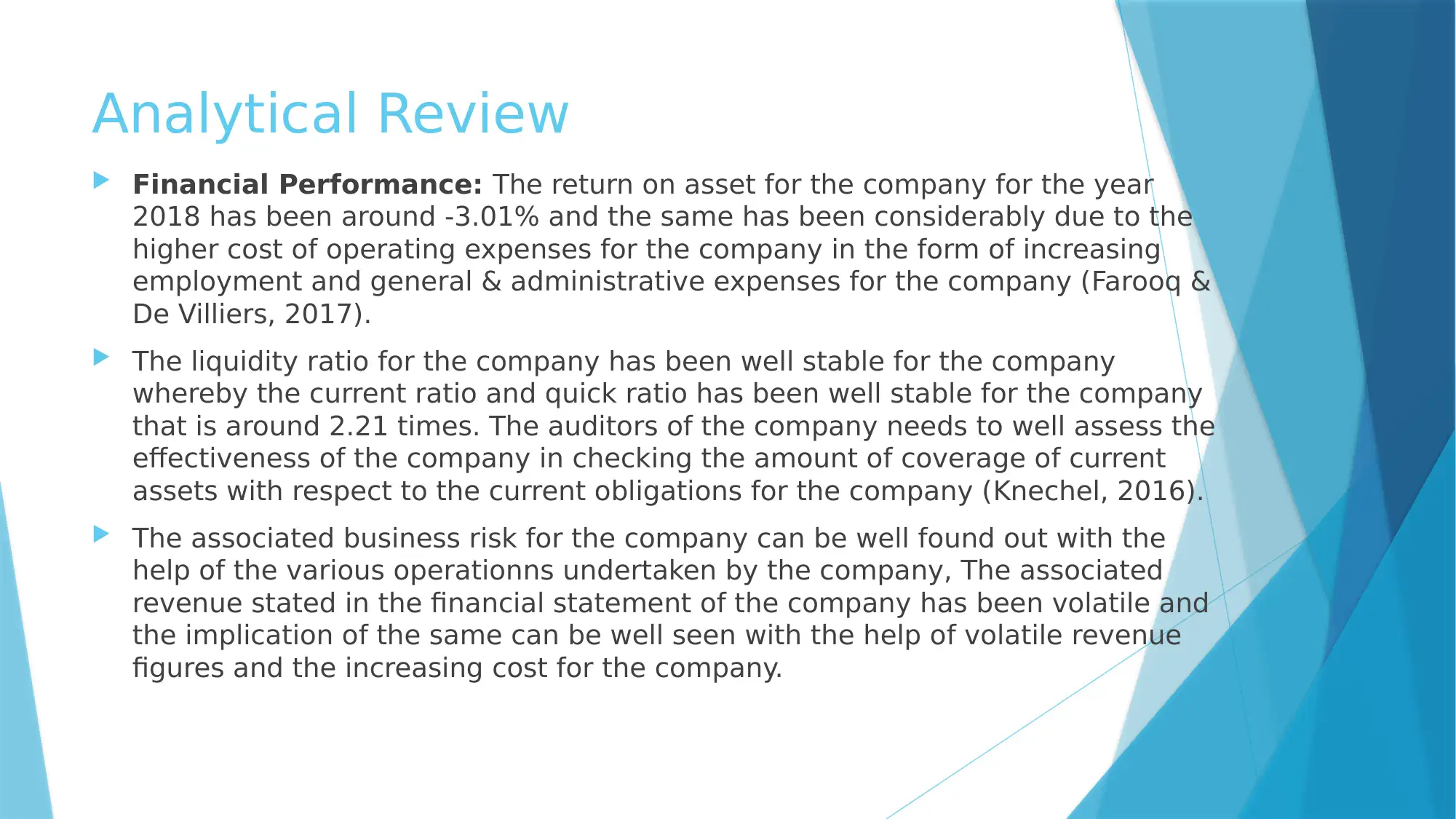
Analytical Review
Financial Performance: The return on asset for the company for the year
2018 has been around -3.01% and the same has been considerably due to the
higher cost of operating expenses for the company in the form of increasing
employment and general & administrative expenses for the company (Farooq &
De Villiers, 2017).
The liquidity ratio for the company has been well stable for the company
whereby the current ratio and quick ratio has been well stable for the company
that is around 2.21 times. The auditors of the company needs to well assess the
effectiveness of the company in checking the amount of coverage of current
assets with respect to the current obligations for the company (Knechel, 2016).
The associated business risk for the company can be well found out with the
help of the various operationns undertaken by the company, The associated
revenue stated in the financial statement of the company has been volatile and
the implication of the same can be well seen with the help of volatile revenue
figures and the increasing cost for the company.
Financial Performance: The return on asset for the company for the year
2018 has been around -3.01% and the same has been considerably due to the
higher cost of operating expenses for the company in the form of increasing
employment and general & administrative expenses for the company (Farooq &
De Villiers, 2017).
The liquidity ratio for the company has been well stable for the company
whereby the current ratio and quick ratio has been well stable for the company
that is around 2.21 times. The auditors of the company needs to well assess the
effectiveness of the company in checking the amount of coverage of current
assets with respect to the current obligations for the company (Knechel, 2016).
The associated business risk for the company can be well found out with the
help of the various operationns undertaken by the company, The associated
revenue stated in the financial statement of the company has been volatile and
the implication of the same can be well seen with the help of volatile revenue
figures and the increasing cost for the company.
Paraphrase This Document
Need a fresh take? Get an instant paraphrase of this document with our AI Paraphraser
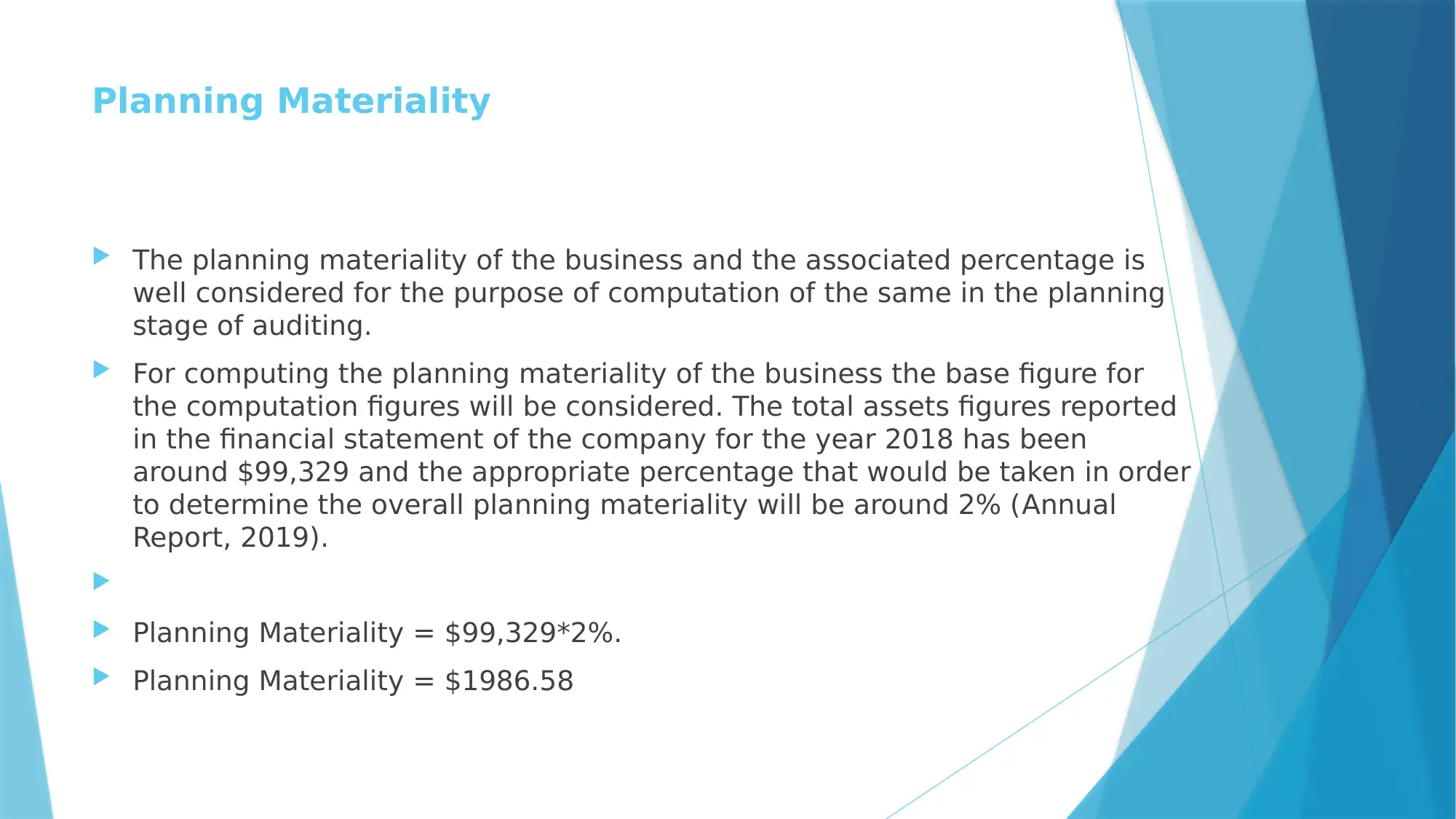
Planning Materiality
The planning materiality of the business and the associated percentage is
well considered for the purpose of computation of the same in the planning
stage of auditing.
For computing the planning materiality of the business the base figure for
the computation figures will be considered. The total assets figures reported
in the financial statement of the company for the year 2018 has been
around $99,329 and the appropriate percentage that would be taken in order
to determine the overall planning materiality will be around 2% (Annual
Report, 2019).
Planning Materiality = $99,329*2%.
Planning Materiality = $1986.58
The planning materiality of the business and the associated percentage is
well considered for the purpose of computation of the same in the planning
stage of auditing.
For computing the planning materiality of the business the base figure for
the computation figures will be considered. The total assets figures reported
in the financial statement of the company for the year 2018 has been
around $99,329 and the appropriate percentage that would be taken in order
to determine the overall planning materiality will be around 2% (Annual
Report, 2019).
Planning Materiality = $99,329*2%.
Planning Materiality = $1986.58

Part B: Quality and Effectiveness of
Independent Audit
Auditing plays an important role in assessing and determining the
overall materiality of the business so that the presented financial
statement gives a true and a fair view.
The Auditor expresses their opinion in regard to the quality of the
financial information which is then used by the investors and
stakeholders of the company for the purpose of assessing the overall
financial performance of the company.
The key functions of an independent Audit is to achieve fundamental
objectives in obtaining a certain reasonable assurance in terms of
stating whether the financial report is free of material misstatement.
Independent Audit
Auditing plays an important role in assessing and determining the
overall materiality of the business so that the presented financial
statement gives a true and a fair view.
The Auditor expresses their opinion in regard to the quality of the
financial information which is then used by the investors and
stakeholders of the company for the purpose of assessing the overall
financial performance of the company.
The key functions of an independent Audit is to achieve fundamental
objectives in obtaining a certain reasonable assurance in terms of
stating whether the financial report is free of material misstatement.
⊘ This is a preview!⊘
Do you want full access?
Subscribe today to unlock all pages.

Trusted by 1+ million students worldwide

Addressing of Audit Concerns by Regulators
Conducting and reviewing the effective quality reviews of the various
Audits that are done for the presented financial statement of the
company.
Finding important and necessary information that might be required
for the purpose of classification and obtaining audit evidences for
preparing the opinion in comparison to the financial report presented.
Identifying and implementing root causes of finding quality reviews
and various other Audit reviews.
An action plan should be well designed and implemented by the
Auditor for the purpose of addressing various findings, monitoring
and revising the action plans for ensuring that the plans undertaken
are well effective.
Conducting and reviewing the effective quality reviews of the various
Audits that are done for the presented financial statement of the
company.
Finding important and necessary information that might be required
for the purpose of classification and obtaining audit evidences for
preparing the opinion in comparison to the financial report presented.
Identifying and implementing root causes of finding quality reviews
and various other Audit reviews.
An action plan should be well designed and implemented by the
Auditor for the purpose of addressing various findings, monitoring
and revising the action plans for ensuring that the plans undertaken
are well effective.
Paraphrase This Document
Need a fresh take? Get an instant paraphrase of this document with our AI Paraphraser
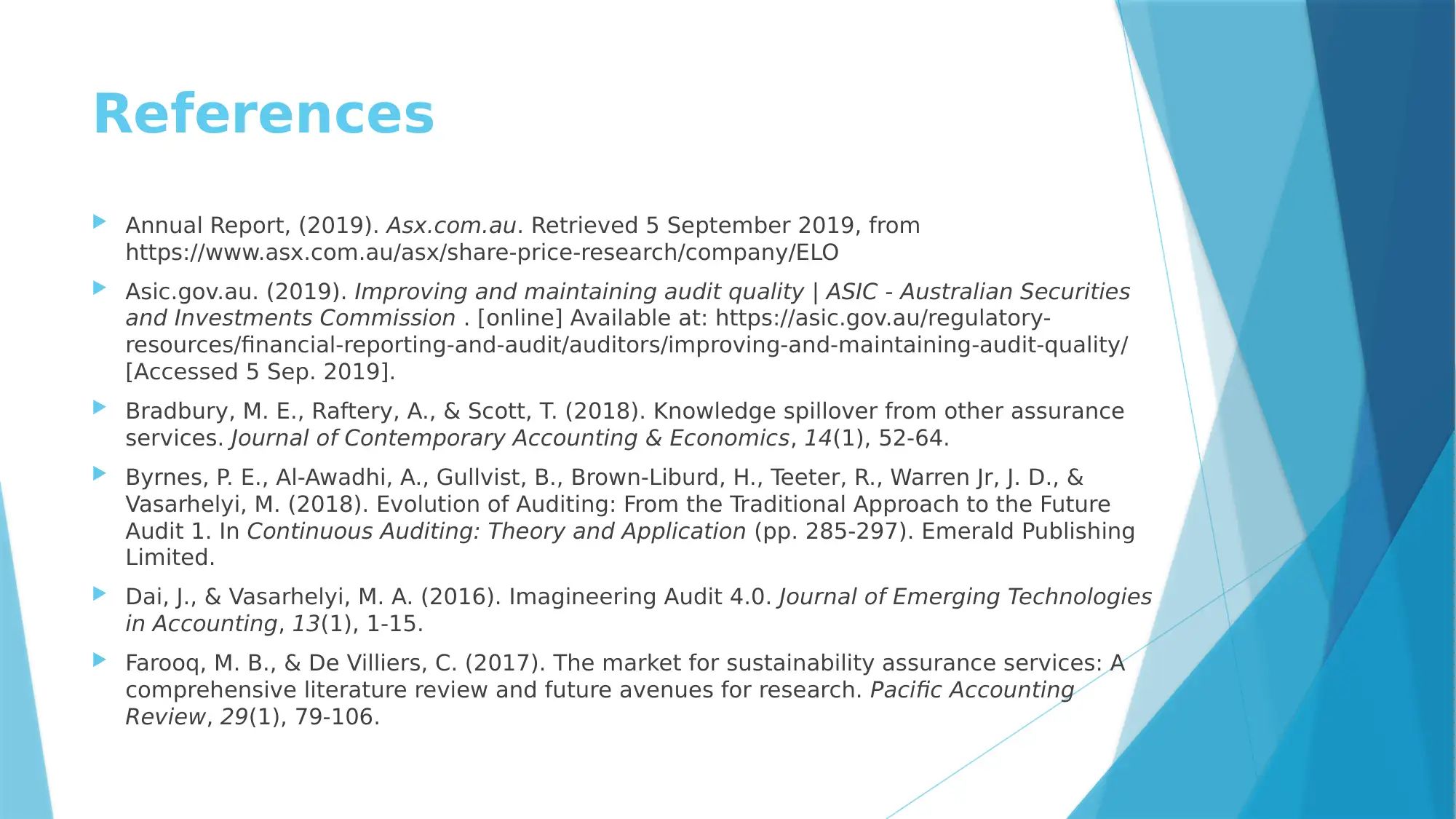
References
Annual Report, (2019). Asx.com.au. Retrieved 5 September 2019, from
https://www.asx.com.au/asx/share-price-research/company/ELO
Asic.gov.au. (2019). Improving and maintaining audit quality | ASIC - Australian Securities
and Investments Commission . [online] Available at: https://asic.gov.au/regulatory-
resources/financial-reporting-and-audit/auditors/improving-and-maintaining-audit-quality/
[Accessed 5 Sep. 2019].
Bradbury, M. E., Raftery, A., & Scott, T. (2018). Knowledge spillover from other assurance
services. Journal of Contemporary Accounting & Economics, 14(1), 52-64.
Byrnes, P. E., Al-Awadhi, A., Gullvist, B., Brown-Liburd, H., Teeter, R., Warren Jr, J. D., &
Vasarhelyi, M. (2018). Evolution of Auditing: From the Traditional Approach to the Future
Audit 1. In Continuous Auditing: Theory and Application (pp. 285-297). Emerald Publishing
Limited.
Dai, J., & Vasarhelyi, M. A. (2016). Imagineering Audit 4.0. Journal of Emerging Technologies
in Accounting, 13(1), 1-15.
Farooq, M. B., & De Villiers, C. (2017). The market for sustainability assurance services: A
comprehensive literature review and future avenues for research. Pacific Accounting
Review, 29(1), 79-106.
Annual Report, (2019). Asx.com.au. Retrieved 5 September 2019, from
https://www.asx.com.au/asx/share-price-research/company/ELO
Asic.gov.au. (2019). Improving and maintaining audit quality | ASIC - Australian Securities
and Investments Commission . [online] Available at: https://asic.gov.au/regulatory-
resources/financial-reporting-and-audit/auditors/improving-and-maintaining-audit-quality/
[Accessed 5 Sep. 2019].
Bradbury, M. E., Raftery, A., & Scott, T. (2018). Knowledge spillover from other assurance
services. Journal of Contemporary Accounting & Economics, 14(1), 52-64.
Byrnes, P. E., Al-Awadhi, A., Gullvist, B., Brown-Liburd, H., Teeter, R., Warren Jr, J. D., &
Vasarhelyi, M. (2018). Evolution of Auditing: From the Traditional Approach to the Future
Audit 1. In Continuous Auditing: Theory and Application (pp. 285-297). Emerald Publishing
Limited.
Dai, J., & Vasarhelyi, M. A. (2016). Imagineering Audit 4.0. Journal of Emerging Technologies
in Accounting, 13(1), 1-15.
Farooq, M. B., & De Villiers, C. (2017). The market for sustainability assurance services: A
comprehensive literature review and future avenues for research. Pacific Accounting
Review, 29(1), 79-106.

THANK YOU
⊘ This is a preview!⊘
Do you want full access?
Subscribe today to unlock all pages.

Trusted by 1+ million students worldwide
1 out of 9
Related Documents
Your All-in-One AI-Powered Toolkit for Academic Success.
+13062052269
info@desklib.com
Available 24*7 on WhatsApp / Email
![[object Object]](/_next/static/media/star-bottom.7253800d.svg)
Unlock your academic potential
Copyright © 2020–2025 A2Z Services. All Rights Reserved. Developed and managed by ZUCOL.




